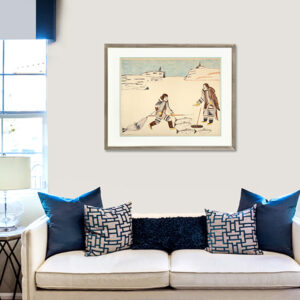
Arctic Wind V: drawing from the land 2016
ONLINE ONLY EXHIBITION
Opens July 1 – August 15, 2016
Drawing allows the Inuit to create a visual history of their culture and way of life. To remember what has past and what is now before them is paramount. Remembering the traditions of living from nature and the surrounding land is to pay homage to their heritage.
Inuit artists are inspired by the terrain and multitude of flora, fauna and animal life to create realistic and fantastical imagery. Their drawings tend to be descriptive narratives as it’s much easier for the artist to tell a story through illustration than sculpture. Often the Inuit will refer to these drawings as “memory art” as they are taken from their personal memories.
In visualizing the world around them, these artists realized early on that they are not restricted by realistic images and, if they are more comfortable drawing what they feel, then their interpretations of scenery, animals and other imagery can be personalized even more.
For Inuit women, it is significant that drawing shifted their social status within the community and the pencil in their hand became as powerful as a man’s spear for hunting. By possessing the ability to survive without a hunter to gather food for them, these women could experience independence and raise a family on their own.
The Arctic Wind V 2016 exhibition collection, as a part of the gallery’s continuing series, illustrates how five prominent Cape Dorset artists exemplify the concept of drawing from the land.
Kenojuak Ashevak (1927-2013); “When I started drawing my artwork, I was just given a pencil and I started to draw (the pencil was given to her by James Houston in 1958). I just kind of moved the pencil around and started drawing. For drawing animals, or something like that, it’s not really coming from the animals but from how I feel.”
“When I first started to make a few lines, he [Johnniebo, her sweetheart] smiled at me and said ‘Inumn’, which means ‘I love you’. I just knew inside my heart that he almost cried knowing that I was trying my best to say something on a piece of paper that would bring food to my family. I guess I was thinking of the animals and beautiful flowers that covered our beautiful, untouched land.”
Although widely recognized for her fascination with birds, both real and imaginary, it is refreshing to have Kenojuak’s two drawings ‘Summer Camp Life’ and ‘Scouting Dog’ featured in Arctic Wind V to demonstrate her versatility and dexterity as an artist.
Tim Pitsiulak’s (1967) aunt Kenojuak Ashevak has been influential artistically, although the imagery in his drawings are focused primarily on water mammals and the oceanic landscape in which they live. While on hunting expeditions, he takes hundreds of photos which are often used later as the inspiration for his drawings. He captures the moments that translate into his way of life – living from the land and sea.
Known for his sensitivity and gentleness, Kavavaow Mannomee’s (1958) drawings reflect a softness and a quiet solitude as though these creatures are undisturbed by the artist’s observation. The interaction and connection between the figures are quite intimate and tender. Often his engaging imagery of colourful birds are interpretive flights of fantasy with a delicate sense of colour as demonstrated in Kavavaow’s drawing ‘Bird Dance’.
Recognized as an accomplished photographer since 1948, Peter Pitseolak (1902-1973) depicted aspects of a disappearing life. Later in his artistic career, these photographs were the resource and inspiration for his drawings such as ‘Man with Seal and Woman Jigging for Fish’.
As a new generation artist, Ningeokuluk Teevee (1963) is challenging the preconceptions of what it means to be Inuit and she strives to redefine its definition. Teevee loves the intensity of colour especially against a black background as it creates depth and drama, which is most evident in ‘Somber Loons’ and ‘Family of Guillemots’. Her whimsical, overly exaggerated birds in the drawings ‘Nunami’ and ‘Nesting Owl’ fill the entire space while the landscape fades into the background and the eyes powerfully captivate the viewer in a locked stare.
We extend our gratitude to these accomplished artists whose enduring traditions continue to deepen our appreciation and respect for their culture.
To view more of these artists’ works in our gallery collection – please visit our home page and search by artist name.




